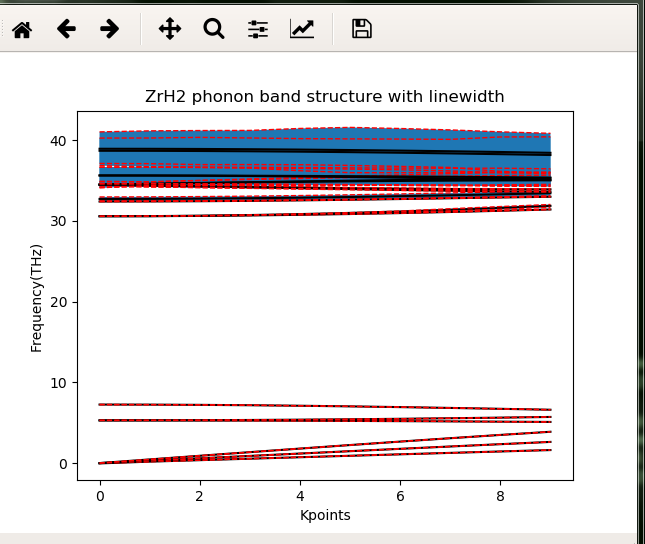以ZrH2为例.
1.
post-processing:
计算linewidth at different q-points:
phono3py --fc3 --fc2 --dim="2 2 2" --loglevel=2 --mesh="64 64 64" -c POSCAR-unitcell --ga="0 0 0 1 1 1 2 2 2 3 3 3 4 4 4 5 5 5 6 6 6 7 7 7 8 8 8 9 9 9 10 10 10 11 11 11 12 12 12 13 13 13 14 14 14 15 15 15 16 16 16 17 17 17 18 18 18 19 19 19 20 20 20 21 21 21 22 22 22 23 23 23 24 24 24 25 25 25 26 26 26 27 27 27 28 28 28 29 29 29 30 30 30 31 31 31 32 32 32" --lw --bi="1,2,3,4,5,6,7,8,9,10,11,12,13,14,15,16,17,18"
这样会对BZ取64*64*64个点,然后算ga中每三个数值决定的一个q点.
画出phonon linewidth 分布图:
1 #!/usr/bin/env python 2 3 import os 4 import sys 5 import numpy as np 6 import matplotlib.pyplot as plt 7 8 lw_dir = "linewidth" 9 freq_file = "m646464.out" 10 temp = 10 # temperature 11 lw_factor = 10.0 # magnified factor 12 13 def readOutput(file_name): 14 with open(file_name, 'rb') as f: 15 all_lines = f.readlines() 16 17 all_found = 0 18 for i in range(len(all_lines)): 19 if all_found == 3: 20 break 21 elif "Mesh sampling" in all_lines[i]: 22 mesh = map(int, all_lines[i].split()[3:6]) 23 all_found += 1 24 elif "Band indices" in all_lines[i]: 25 band_index = map(int, all_lines[i].replace('[','').replace(']','').split()[2:]) 26 all_found += 1 27 elif "Grid point to" in all_lines[i]: 28 gp_index = map(int, all_lines[i+1].split()[:]) 29 all_found += 1 30 31 return mesh, band_index, gp_index 32 33 def getLW(grid_index, temp, mesh, n_band): 34 lw_grid = [] 35 mesh_file_name = ''.join(map(str, mesh)) 36 for i in range(n_band): 37 file_name = os.path.join(lw_dir, 'linewidth-m'+mesh_file_name+'-g'+str(grid_index)+'-b'+str(i+1)+'.dat') 38 with open(file_name, 'rb') as f: 39 all_lines = f.readlines() 40 41 for line in all_lines: 42 # add space and 0000 to avoid alias 43 if (" "+str(float(temp))+"0000") in line: 44 lw_grid.append(float(line.split()[-1])) 45 46 if len(lw_grid) != n_band: 47 print("Error! ") 48 sys.exit(1) 49 50 return lw_grid 51 52 def getFreq(grid_index, n_band): 53 freq_grid = [] 54 with open(freq_file, 'rb') as f: 55 all_lines = f.readlines() 56 57 for i in range(len(all_lines)): 58 if " Grid point" in all_lines[i] and int(all_lines[i].split()[3]) == grid_index: 59 # may have different lines for this data block 60 for j in range(i+5, i+9): 61 freq_grid.extend(map(float, all_lines[j].strip().lstrip('[').rstrip(']').split()[:])) 62 if ']' not in all_lines[i+8]: 63 freq_grid.extend(map(float, all_lines[i+9].strip().lstrip('[').rstrip(']').split()[:])) 64 65 if len(freq_grid) != n_band: 66 print("Error! ") 67 sys.exit(1) 68 69 return freq_grid 70 71 72 # Main routine 73 mesh, band_index, gp_index = readOutput(freq_file) 74 75 freq = [] 76 lw = [] 77 n_band = len(band_index) 78 x = range(len(gp_index)) 79 80 for grid_index in gp_index: 81 lw_tmp = getLW(grid_index, temp, mesh, n_band) 82 lw.append(lw_tmp) 83 84 freq_tmp = getFreq(grid_index, n_band) 85 freq.append(freq_tmp) 86 87 lw_upper = np.add(freq, 0.5*lw_factor*np.array(lw)) 88 lw_lower = np.add(freq, -0.5*lw_factor*np.array(lw)) 89 90 freq_plot = zip(*freq) 91 lw_plot = zip(*lw) 92 lw_upper_plot = zip(*lw_upper) 93 lw_lower_plot = zip(*lw_lower) 94 95 fig,ax = plt.subplots() 96 for i in range(n_band): 97 ax.plot(x, freq_plot[i], color='black') 98 ax.plot(x, lw_upper_plot[i], x, lw_lower_plot[i], linestyle='--', linewidth=1, color='red') 99 ax.fill_between(x, lw_upper_plot[i], lw_lower_plot[i], where=np.array(lw_upper_plot[i]) >= np.array(lw_lower_plot[i]), facecolor=None, interpolate=True) 100 #ax.fill_between(x, lw_upper_plot[i], lw_lower_plot[i], where=np.array(lw_upper_plot[i]) >= np.array(lw_lower_plot[i]), markerfacecolor="None", interpolate=True) 101 ax.set_title('ZrH2 phonon band structure with linewidth') 102 ax.set_xlabel('Kpoints') 103 ax.set_ylabel('Frequency(THz)') 104 plt.show()
